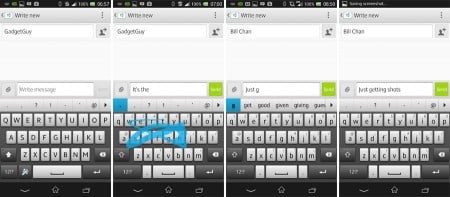The latest version of Sony’s Android overlay is also very easy to use here, with multiple homescreens that are easy to customise, user replaceable dock icons and shortcuts, an app menu system that can be re-ordered quickly, and a dropdown shortcut bar to access settings.
Sony has also thrown in something called “small apps,” which pop up when you press the multitask button on the bottom right.
Aside for being able to flick out apps from memory – a feature of Android for over a year now – Sony’s small apps allow you to quickly grab a calculator, timer, voice recorder, unit converter, or jot down some notes with a small overlay that sits on top of everything on your homescreen.
Overall, this feels like Sony’s answer to the LG QMemo or Samsung’s note taking facility built into the Galaxy Note 2, and if you like multitasking easily, you’ll find this a useful feature on the Xperia Z.

The keyboard has also been improved too, and you’ll find that you can either type using the traditional virtual keyboard we’ve all seen, or drag your fingers over the letters in a Swype-like fashion.
This isn’t as good as what we’ve experienced in SwiftFlow, but does provide a decent experience for speedy typing.
We’re very much into the water and dust proofing Sony has built into this phone, with the knowledge learned from last year’s Xperia Go. This is a smartphone you shouldn’t feel concerned about taking out with you, because even if you get some muck on it, you can easily wash it off.
Run it under the tap and the smartphone is fine, the water running off and still functioning. If your device is on at the time, working and out of standby, you’ll see the touchscreen try to respond to the flow of water, the heaviness of the touch acting like slippery fingers.
The handset also apparently resists dust, though we didn’t have much to test that with here.
Performance-wise, this thing flies, pushing so far past last year’s HTC One X that its performance is nearly double that of that handset. Synthetic benchmarks don’t necessarily mean much, but according to our bench on Quadrant, the quad-core CPU on offer is capable of some decent speeds.
Transfer speeds will depend on where you are, but we managed speeds of around 20 to 30Mbps in the city, which was more than adequate for 4G.
The average battery life could be better, but offers what seems to be par for the course for a 4G LTE handset, with one day of life easily possible from this handset. You might get a little more, but in general, our day of web browsing, text writing, phone calls, picture taking, the odd game, and benching proved the typical 4G life of a day.
To Sony’s credit, there are some energy savings options not normally native to Android that have been thrown in here, such as the Stamina mode, which lets you selectively enable and disable the background downloading of various apps, among other things, to help retain a better battery life.
And then there’s that camera, that nifty 13.1 megapixel camera, which carries a easy-to-use interface that feels like it was lifted straight from Sony’s compact cameras.
There’s still no optical zoom like we get on a proper camera, but there is a “Superior Auto” mode which can pinpoint which settings to use best in most situations, while the “Picture Effect” mode carries nine different effects with real-time previews of each on-screen.














Stupid question, can the battery be replaced if it dies?
It’s part of the phone on this one, so if it can be, it won’t be by a customer.
The viewing angle, front on only is a concern. Odd when Sony make such great TV’s and this is not an issue. In fact I put some fairly serious cash on the table and purchased a 46″ bravia in January after doing every comparison possible.
On the plus side, the just released Galaxy S4 is using Sony’s camera tech which speaks volumes with Samsung expecting to sell 100 million units this year alone.
Early next year, Sony may be one of a few manufacturers bringing Firefox (Mozilla) O/S to the retail space in possibly a flagship device. Can’t wait for that.